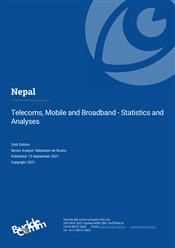Nepal Telecoms Market Report
Telecoms, Mobile and Broadband - Statistics and Analyses

Publication Date: April 2024
Report Pages: 114
Analyst: Sebastien De Rosbo
Nepal’s broadband traffic grows but data rates remain low
In relation to its telecom sector, Nepal has several topographical and economic constraints which have impeded efforts to expand network infrastructure and improve the quality of service for end-users.
The fixed line market remains underdeveloped, and as a result most traffic is channeled via mobile networks. Fixed broadband penetration remains very low, though to address this the government has initiated several programs as part of the Digital Nepal Framework and the wider Optical Fibre Backbone Network Expansion Project, started in 2012. Supported by the Rural Telecommunications Development Fund, the programs include building out fibre backbone infrastructure and using this to provide broadband to schools and community centres nationally.
Telcos have also invested in fibre networks, and competition in the market is intensifying. Cheap fibre-based services launched by CG Net in mid-2021 prompted responses from other ISPs to provide faster and more competitively priced offers.
Nepal’s mobile market is relatively developed, with a focus on LTE. In 2021, the regulator considered a range of spectrum bands which could be used for 5G, while Nepal Telecom was charged with trialing services in five cities.
BuddeComm notes that the pandemic continues to have a significant impact on production and supply chains globally. During the coming year the telecoms sector to various degrees is likely to experience a downturn in mobile device production, while it may also be difficult for network operators to manage workflows when maintaining and upgrading existing infrastructure. Overall progress towards 5G may be postponed or slowed down in some countries.
On the consumer side, spending on telecoms services and devices is under pressure from the financial effect of large-scale job losses and the consequent restriction on disposable incomes. However, the crucial nature of telecom services, both for general communication as well as a tool for home-working, will offset such pressures. In many markets the net effect should be a steady though reduced increased in subscriber growth.
Although it is challenging to predict and interpret the long-term impacts of the crisis as it develops, these have been acknowledged in the industry forecasts contained in this report.
The report also covers the responses of the telecom operators as well as government agencies and regulators as they react to the crisis to ensure that citizens can continue to make optimum use of telecom services. This can be reflected in subsidy schemes and the promotion of tele-health and tele-education, among other solutions.
Key developments:
- Government facilitates e-learning with free internet access and data packages for students, provides funds to connect schools in all 66 districts to the internet;
- Nepal Telecom asks for free spectrum to trial 5G services, plans to close down WiMAX service;
- Nepali Digital Payment Company launches an m-money service;
- Regulator allows telcos to refarm 900MHz spectrum for LTE use, updates infrastructure sharing rules;
- Nepal Telecom secures additional 1800MHz spectrum, closes CDMA network;
- Nepal’s first national satellite to be launched in 2022;
- Report update includes an assessment of the global impact of Covid-19 on the telecoms sector, the regulator’s market reports to May 2021, telcos’ operating and financial data to July 2021, Telecom Maturity Index charts and analyses, recent market developments.
Companies mentioned in this report
Nepal Telecom (NDCL), United Telecom (UTL), Ncell, Telia Company, STM Telecom, Nepal Satellite Telecom (NSTPL), Smart Telecom (STPL)
Related Reports
- 2019 Asia - Mobile Network Operators and MVNOs
- 2019 Asia - Fixed Broadband Market - Statistics and Analyses
- 2019 Asia - Mobile Infrastructure and Mobile Broadband
- Armenia - Telecoms, Mobile and Broadband - Statistics and Analyses
- Bangladesh - Telecoms, Mobile and Broadband - Statistics and Analyses
- Japan - Telecoms, Mobile and Broadband - Statistics and Analyses
- Cambodia - Telecoms, Mobile and Broadband - Statistics and Analyses
- Philippines - Telecoms, Mobile and Broadband - Statistics and Analyses
- Laos - Telecoms, Mobile and Broadband - Statistics and Analyses
- Singapore - Telecoms, Mobile and Broadband - Statistics and Analyses
Share this Report
TMT Intelligence
A platform to scale your intelligence tasks
Monitor critical insights with our AI-powered Market Intelligence Platform gathering and analyzing intelligence in real time. With AI trained to spot emerging trends and detect new strategic opportunities, our clients use TMT Intelligence to accelerate their growth.
If you want to know more about it, please see:
Research Methodology
BuddeComm's strategic business reports contain a combination of both primary and secondary research statistics, analyses written by our senior analysts supported by a network of experts, industry contacts and researchers from around the world as well as our own scenario forecasts.
For more details, please see:
More than 4,000 customers from 140 countries utilise BuddeComm Research
Are you interested in BuddeComm's Custom Research Service?
Hot Topics
News & Views
Have the latest telecommunications industry news delivered to your inbox by subscribing to BuddeComm's weekly newsletter.